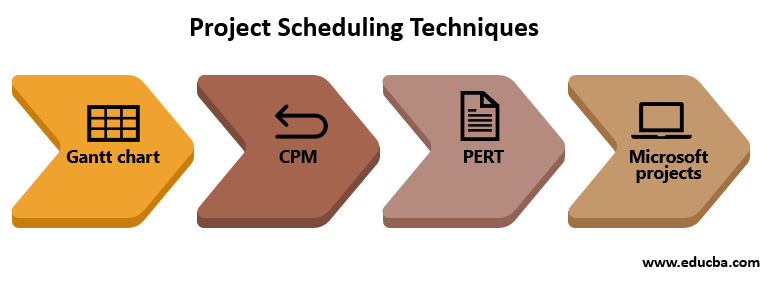
Overview of Project Scheduling Example
Project scheduling or project planning in project management are the listings of milestones, activities, and deliverables with start and finish dates of the project. In this topic, we are going to learn about Project Scheduling Example.
The estimation of resource allocation, budget and duration are directly linked with dependencies and scheduled events. In project management, project scheduling is used in project planning and project portfolio management. Project scheduling is just part of the project planning. Scheduling is determined by the timing and sequence of operations to give completion time, Work breakdown structure terminal elements, the statement of work or a contract data requirements list and on needed for completion of the project.
Project Scheduling Steps and Techniques
Project schedules have several steps and techniques to follow throughout the project.
Steps are
- Define Activities
- Sequence activities
- Estimate time and
- Develop schedule
Techniques are
All the Techniques comes with some limitations and can be used based on the requirements for project scheduling –
- Gantt chart- This is represented by the graph or bar chart with a specific bar for activities in the project that shows the passage of time. Gantt chart limits a clear indication of interrelation between the activities.
- CPM- Critical path method was developed for industrial projects where activity times are generally known.
- PERT- Program evaluation and review technique were developed for R&D projects where activity times are generally uncertain. Its prime objective is taking the shortest possible time.
- Microsoft projects- All the work is performed on the computer memory and changes can be saved only when the program is asked to operate.
Examples of Project Scheduling
When we talk of scheduling in the construction industry, it works on a different frame as compared to the software industry because of its complexity with the workforce. In the construction schedule, the networks are analyzed using three methods CPM for calculations, Primavera project management software P5, and mathematical model using OPL.
The schedule is generated using technique CPM that is the critical path method. CPM can be used for scheduling several field projects like scheduling in construction, aerospace and defense, software development, research projects, product development, engineering, and plant maintenance. Construction projects require periodic schedule updates, these updates act as an assessment of the project status and predict when to expect its completion. Proper updating about the schedule between the parties through a critical communication tool is an integral part of project management. The schedule is expected to reflect the current plan to reach the finishing stage also with a proper record of past performance.
The CPM method can be used for mathematical analysis. CPM fastens the completion of the project, it also identifies the delays in the process which can affect the completion date of the whole project, it also works well with repetitive activities. CPM calculations are done with a forward pass and backward pass, the forward pass calculates the earliest start dates to calculate project completion date similarly the backward press calculates the latest start date of the activity and identify the critical path from the graph.
The major steps in updating schedule will involve-
- Setting a baseline
- Updating the schedule
- Comparing schedule updates
Project scheduling in software planning is a little different from the construction industry. It starts with the objective of the project –
It introduces the project detail, examines the stages of planning- scope, estimation, risk analysis, scheduling, focus on tools and techniques that are previously available. The scheduling part holds the command of allocating resources along the timeline and set the milestones. The software industry uses PERT and CPM techniques for their scheduling process.
CPM maintains the chain of the task and determines the duration of the project. Determine the earliest time when can task begins and the latest time for program initiation that will not delay the project. Completion of task on time. It has a total float to maximize slippage without overall delay. Automated tools are implemented and often use a task network as input.
MS project tracking schedule- this process involves setting a baseline, updating a schedule status and comparing the updates to baseline or previous updates. For schedule set up, it is very crucial to select the correct options and relevant points in the time display, and do not rely on data date because the status date sounds like data date in primavera but it is not the same.
Split in-progress tasks allow re-scheduling or remaining duration and work when in progress and taking longer than originally planned. The MSP should schedule tasks according to their constraint dates. The task status can be updated and ensures that the resource status does not override update status. Update and match the end of the completed part back to the status date to prevent actual dates later than the status date.
Updating the Schedule
It is necessary to understand how to calculate durations!
- Duration (actual+ remaining duration)
- Actual duration
- Remaining duration
- Complete percentage (actual duration/ duration).
Observing the status date with MSP is a complicated process that requires an understanding of the calculation’s options using reschedule uncompleted work on the update project form.
Reschedule uncompleted work to start after is the important feature to keep available on the form, it can easily be done by the split in progress task under tools, options schedule tab.
Conclusion
MSP is considered good for beginners and is very user-friendly techniques and inexpensive. The one who has no experience of scheduling can pick up MSP and just needed is MS office user. Yet the use of MSP in the construction business is not considered because there is a struggle in updating and maintaining the schedule. The CPM is considered a good method for construction business, yet it is expensive but worthy.
For analyzing construction projects three mathematical models are used-
- Model 1: To minimize project completion time the linear programming model is used.
- Model 2: To minimize crushing costs.
- Model 3: to minimize the project completion times and crashing costs using a linear programming model to solve fuzzy objective formulation.
Recommended Articles
This is a guide to Project Scheduling Example. Here we discuss the examples, several steps, and techniques of project scheduling. You can also go through our other suggested articles to learn more –

